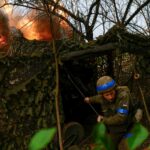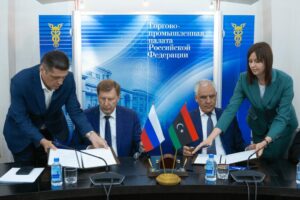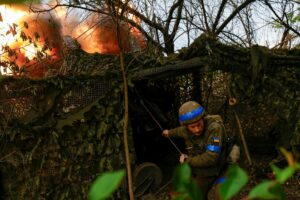At close to midnight in Goris, the cars keep on coming. There are old Soviet vehicles with misshapen bundles strapped to the roofs. Trunks filled with suitcases and blankets. Entire lives gathered together in a couple of bags.
This resort town nestled on the Armenia-Azerbaijan border, at the mouth of the only route in and out of the fast-fading self-declared Republic of Nagorno-Karabakh, which Armenians call Artsakh, has been overwhelmed by a historic exodus of refugees, as thousands of people have fled an impending takeover by Azerbaijan.
With Baku poised to reassert authority over the entire region, which it seized during a brief war in 2020 after decades of Armenian control, some local officials predicted that the entire population of Nagorno-Karabakh — numbering perhaps 120,000 — could end up trying to evacuate, fearing genocide and unwilling to live in Azerbaijan.
On Tuesday, the head of the U.S. Agency for International Development, Samantha Power, called on Azerbaijan to protect the rights of civilians in the region and allow access for international monitors and humanitarian organizations.
Power, who traveled to Armenia to pledge U.S. support, cited “very troubling reports” of violence by Azerbaijani forces against civilians, and called on President Ilham Aliyev’s government to “maintain the cease-fire and take concrete steps to protect the rights of civilians in Nagorno-Karabakh.”
In Armenia, Power met people fleeing the region. By late Tuesday, Armenian authorities said more than 28,000 refugees had arrived in Armenia since Sunday, more than 18 percent of the region’s population.

The region is recognized internationally as the sovereign territory of Azerbaijan but has been in dispute for decades, since Armenia seized control of it during a war in the late 1980s and early 1990s amid the collapse of the Soviet Union. Azerbaijan took back most of the territory during the war in 2020, but a cease-fire brokered by Russia left uncertain the fate of thousands of ethnic Armenians, including residents of the capital, Stepanakert.
The failure of Russian peacekeepers to control the situation reflected widening instability in countries that long looked to Moscow as the regional power but now find the Kremlin highly distracted by its war in Ukraine. Last year, an escalation of border clashes between Kyrgyzstan and Tajikistan was also partly blamed on Russia’s preoccupation with Ukraine.
Thousands have fled by car, fearing violence from Azerbaijan’s advancing forces. At least 68 Nagorno-Karabakh Armenians waiting for gasoline died as a result of a fuel depot explosion in Stepanakert on Monday, while 290 were injured, according to the office of the Nagorno-Karabakh ombudsman. An additional 105 people were still missing Tuesday.
Officials in the self-declared Nagorno-Karabakh region announced air evacuations of the most seriously injured victims in Monday’s blast, with the Stepanakert’s limited medical facilities overwhelmed and the only road to Armenia largely blocked by the torrent of cars of those leaving their homes, probably forever.
Dozens of patients were in critical condition, officials said. Of the nearly 300 wounded, 168 were rushed to treatment centers in Armenia on Tuesday, according to the Nagorno-Karabakh ombudsman.
Earlier Tuesday, Armenian media cited the health minister, Anahit Avanesyan, stating that the bodies of 125 people had been taken to forensic centers in Armenia. Nagorno-Karabakh’s information center said late Tuesday that those killed in last week’s fighting were taken to Armenia, while the bodies of those killed in the gas explosion were to be moved later.
In Goris’s central square, a theater was converted into a makeshift refugee center. A 24-year-old volunteer working at the theater, Amalia Arstamyam, left Artsakh a month ago and is waiting to reunite in Goris with her parents and seven siblings. But on Tuesday, she received terrible news. Following the fuel depot explosion in Stepanakert, her uncle and 19-year-old cousin Marta were severely injured.
“She was so badly burned, the doctors say she may not survive,” Arstamyam said.
As the exodus accelerated, Power announced that the United States would provide $11.5 million in humanitarian aid to assist those fleeing. On Monday, she met Armenian Prime Minister Nikol Pashinyan, who alleged that ethnic cleansing was underway.
Every few minutes, on the mountain highway connecting the Armenian capital, Yerevan, with an area called the Lachin Corridor and Nagorno-Karabakh, another ambulance screeched by late Tuesday, the blue lights illuminating the night.
Medics were rushing to Yerevan, carrying the injured from Nagorno-Karabakh. Some were hurt during a swift and brutal Azerbaijani military operation last week; others in Monday’s fuel depot explosion. Traveling in the opposite direction, trucks with cargo bound for Iran slowly snaked their way along the main road connecting landlocked Armenia to its neighbors.
Russian helicopters transferred a number of critically injured patients to Armenian territory, according to the Russian Defense Ministry, but it did not offer details on the numbers or where precisely they were taken.
In 2020, Moscow aggressively inserted itself into the role of peacemaker, but its efforts have largely failed, partly perhaps because of the Kremlin’s focus on its war in Ukraine.
In response to widespread criticism in Armenia of Russia’s role, Kremlin spokesman Dmitry Peskov on Tuesday skirted calls by U.S. and Armenian officials for an international mission to monitor the security of Armenians in Nagorno-Karabakh under Azerbaijani rule, with Moscow and Baku apparently loath to agree.
Peskov said there could be no such mission without Baku’s consent, avoiding the question of Moscow’s stance.
“For our part, we stay in contact with Yerevan, Baku and ethnic Armenians in Karabakh,” Peskov said. On Monday, he denied Russia bore any responsibility for the crisis.

Last week’s military operation by Azerbaijan followed a roughly nine-month blockade of the sole road connecting Nagorno-Karabakh to Armenia through the Lachin Corridor. The blockade caused a humanitarian crisis, including shortages of food.
Power on Tuesday met local officials in the Armenian city of Goris, where thousands of refugees are arriving.
“It is very difficult to hear and see what these families are going through. Many left their towns and villages under shelling,” she said.
Matthew Miller, a State Department spokesman, on Monday called for “an international mission to provide transparency, reassurance and confidence to the residents of Nagorno-Karabakh and the international community, that … their rights and security will be protected consistent with the public statements that Azerbaijan has made.”
Russia’s Foreign Ministry, meanwhile, has bitterly criticized Armenian authorities, even as Yerevan faces a massive influx of civilians fleeing Nagorno-Karabakh.
After Pashinyan criticized Russian actions in the region during a televised address Sunday, blaming Russia for failing to prevent last week’s attacks, the Russian Foreign Ministry accused Yerevan of “unacceptable attacks on Russia,” claiming these were “inspired by the West.”
“The Armenian leadership is making a huge mistake by deliberately attempting to sever Armenia’s multifaceted and centuries-old ties with Russia, making the country a hostage to Western geopolitical games,” the ministry said in a statement Monday.
As thousands left Nagorno-Karabakh by car, clogging the road from Stepanakert, local officials urged residents to delay their journey or to avoid taking their cars with them, and travel by bus instead. Many, however, may not want to return to the region after it reverts to Azerbaijani rule.
Father David Gishyan, 33, a priest from Sisian in Armenia, had been assisting refugees in Goris since the early hours of the morning. He planned to work through the night.
“The buses keep on coming. We meet them here and then send them on their way to different regions across Armenia,” he said. “Mostly, the people arriving don’t understand at all what has happened to them. At first, they experience stress, but then they realize they could never have stayed in Artsakh. Many of their relatives were killed, including children. Once they escape they are lost. … They are faced with the unknown.”
Triumphal claims of victory by Aliyev last week and his boasts that his country had restored its territorial integrity with an “iron fist” have left Armenians in Nagorno-Karabakh fearful of persecution once Baku takes control. Azerbaijan has declared that its government agencies will take over in the region, and that the local population will “reintegrate” into Azerbaijani society.
Meeting Turkish President Recep Tayyip Erdogan on Monday, Aliyev said the rights of Armenians in Nagorno-Karabakh would be “guaranteed by the Azerbaijani state,” a statement that few living in the region trust given the decades of ethnic hatred between the two warring countries.
Source : WASHINGTONPOST















